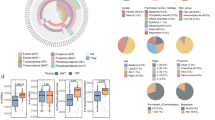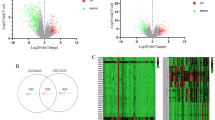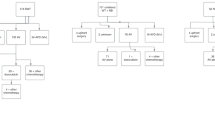Abstract
Nephroblastoma (Wilms’ tumor; WT) is the most common renal tumor of childhood. To date, several genetic abnormalities predisposing to WT have been identified in rare overgrowth syndromes. Among them, abnormal methylation of the 11p15 region, GPC3 and DIS3L2 mutations, which are responsible for Beckwith–Wiedemann, Simpson–Golabi–Behmel and Perlman syndromes, respectively. However, the underlying cause of WT remains unknown in the majority of cases. We report three unrelated patients who presented with WT in addition to a constitutional 9q22.3 microdeletion and dysmorphic/overgrowth syndrome. The size of the deletions was variable (ie, from 1.7 to 8.9 Mb) but invariably encompassed the PTCH1 gene. Subsequently, we identified a somatic PTCH1 nonsense mutation in the renal tumor of one patient. In addition, by array comparative genomic hybridization method, we analyzed the DNA extracted from the blood samples of nine patients with overgrowth syndrome and WT, but did not identify any deleterious chromosomal imbalances in these patients. These findings strongly suggest that patients with constitutional 9q22.3 microdeletion have an increased risk of WT, and that PTCH1 have a role in the pathogenesis of nephroblastomas.
Similar content being viewed by others
Log in or create a free account to read this content
Gain free access to this article, as well as selected content from this journal and more on nature.com
or
References
Rivera MN, Haber DA : Wilms’ tumour: connecting tumorigenesis and organ development in the kidney. Nat Rev Cancer 2005; 5: 699–712.
Call KM, Glaser T, Ito CY et al: Isolation and characterization of a zinc finger polypeptide gene at the human chromosome 11 Wilms' tumor locus. Cell 1990; 60: 509–520.
Scott RH, Douglas J, Baskcomb L et al: Constitutional 11p15 abnormalities, including heritable imprinting center mutations, cause nonsyndromic Wilms tumor. Nat Genet 2008; 40: 1329–1334.
DeBaun MR, Siegel MJ, Choyke PL : Nephromegaly in infancy and early childhood: a risk factor for Wilms tumor in Beckwith-Wiedemann syndrome. J Pediatr 1998; 132: 401–404.
Golabi M, Leung A, Lopez C : Simpson-Golabi-Behmel Syndrome Type 1; in Pagon RA, Bird TD, Dolan CR, Stephens K, (eds):: GeneReviews. Seattle (WA): University of Washington: Seattle, 2006.
Astuti D, Morris MR, Cooper WN et al: Germline mutations in DIS3L2 cause the Perlman syndrome of overgrowth and Wilms tumor susceptibility. Nat Genet 2012; 44: 277–284.
Rassekh SR, Chan S, Harvard C, Dix D, Qiao Y, Rajcan-Separovic E : Screening for submicroscopic chromosomal rearrangements in Wilms tumor using whole-genome microarrays. Cancer Genet Cytogenet 2008; 182: 84–94.
Azzi S, Steunou V, Rousseau A et al: Allele-specific methylated multiplex real-time quantitative PCR (ASMM RTQ-PCR), a powerful method for diagnosing loss of imprinting of the 11p15 region in Russell Silver and Beckwith Wiedemann syndromes. Hum Mutat 2011; 32: 249–258.
Idbaih A, Marie Y, Pierron G et al: Two types of chromosome 1p losses with opposite significance in gliomas. Ann Neurol 2005; 58: 483–487.
Muller EA, Aradhya S, Atkin JF et al: Microdeletion 9q22.3 syndrome includes metopic craniosynostosis, hydrocephalus, macrosomia, and developmental delay. Am J Med Genet A 2012; 158A: 391–399.
Cajaiba MM, Bale AE, Alvarez-Franco M, McNamara J, Reyes-M√∫gica M : Rhabdomyosarcoma, Wilms tumor, and deletion of the patched gene in Gorlin syndrome. Nat Clin Pract Oncol 2006; 3: 575–580.
Austruy E, Candon S, Henry I et al: Characterization of regions of chromosomes 12 and 16 involved in nephroblastoma tumorigenesis. Genes Chromosomes Cancer 1995; 14: 285–294.
Molenaar JJ, Koster J, Zwijnenburg DA et al: Sequencing of neuroblastoma identifies chromothripsis and defects in neuritogenesis genes. Nature 2012; 483: 589–593.
Robinson G, Parker M, Kranenburg TA et al: Novel mutations target distinct subgroups of medulloblastoma. Nature 2012; 488: 43–48.
Acknowledgements
We are grateful to the families who participated in this study and to Rémi Houlgatte and Catherine Chevalier from Biogenouest de Nantes, France. We thank the physicians who helped us in the description of the clinical features (Dr Françoise Mechinaud, Dr Odile Menckes, Dr Vannina Giacobi-Millet).
Author information
Authors and Affiliations
Corresponding author
Ethics declarations
Competing interests
The authors declare no conflict of interest.
Rights and permissions
About this article
Cite this article
Isidor, B., Bourdeaut, F., Lafon, D. et al. Wilms’ tumor in patients with 9q22.3 microdeletion syndrome suggests a role for PTCH1 in nephroblastomas. Eur J Hum Genet 21, 784–787 (2013). https://doi.org/10.1038/ejhg.2012.252
Received:
Revised:
Accepted:
Published:
Issue date:
DOI: https://doi.org/10.1038/ejhg.2012.252
Keywords
This article is cited by
-
Differential expression profiling of onco and tumor-suppressor genes from major-signaling pathways in Wilms’ tumor
Pediatric Surgery International (2022)
-
Current recommendations for cancer surveillance in Gorlin syndrome: a report from the SIOPE host genome working group (SIOPE HGWG)
Familial Cancer (2021)
-
Pediatric onco-nephrology: time to spread the word
Pediatric Nephrology (2021)
-
K-Ras, H-Ras, N-Ras and B-Raf mutation and expression analysis in Wilms tumors: association with tumor growth
Medical Oncology (2017)
-
The roles of microRNAs in Wilms’ tumors
Tumor Biology (2016)



